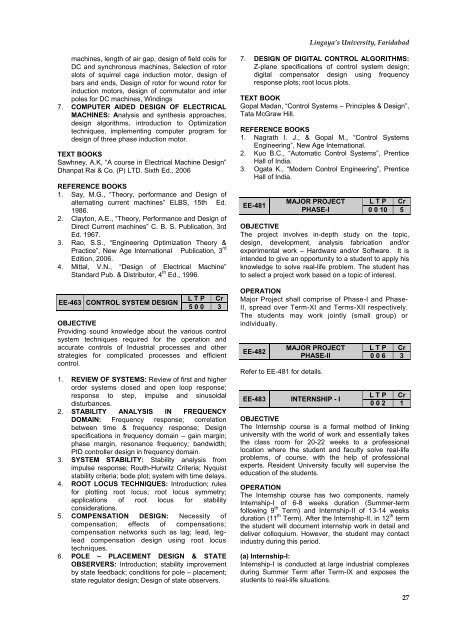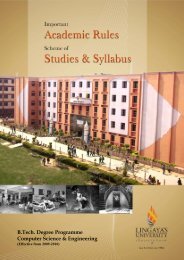Electrical and Electronics - Lingaya's University
Electrical and Electronics - Lingaya's University
Electrical and Electronics - Lingaya's University
Create successful ePaper yourself
Turn your PDF publications into a flip-book with our unique Google optimized e-Paper software.
Lingaya’s <strong>University</strong>, Faridabadmachines, length of air gap, design of field coils forDC <strong>and</strong> synchronous machines, Selection of rotorslots of squirrel cage induction motor, design ofbars <strong>and</strong> ends, Design of rotor for wound rotor forinduction motors, design of commutator <strong>and</strong> interpoles for DC machines, Windings7. COMPUTER AIDED DESIGN OF ELECTRICALMACHINES: Analysis <strong>and</strong> synthesis approaches,design algorithms, introduction to Optimizationtechniques, implementing computer program fordesign of three phase induction motor.TEXT BOOKSSawhney, A.K, ―A course in <strong>Electrical</strong> Machine Design‖Dhanpat Rai & Co. (P) LTD. Sixth Ed., 2006REFERENCE BOOKS1. Say, M.G., ―Theory, performance <strong>and</strong> Design ofalternating current machines‖ ELBS, 15th Ed.1986.2. Clayton, A.E., ―Theory, Performance <strong>and</strong> Design ofDirect Current machines‖ C. B. S. Publication, 3rdEd. 1967.3. Rao, S.S., ―Engineering Optimization Theory &Practice‖, New Age International Publication, 3 rdEdition, 2006.4. Mittal, V.N., ―Design of <strong>Electrical</strong> Machine‖St<strong>and</strong>ard Pub. & Distributor, 4 th Ed., 1996.EE-463 CONTROL SYSTEM DESIGNL T P Cr5 0 0 3OBJECTIVEProviding sound knowledge about the various controlsystem techniques required for the operation <strong>and</strong>accurate controls of Industrial processes <strong>and</strong> otherstrategies for complicated processes <strong>and</strong> efficientcontrol.1. REVIEW OF SYSTEMS: Review of first <strong>and</strong> higherorder systems closed <strong>and</strong> open loop response;response to step, impulse <strong>and</strong> sinusoidaldisturbances.2. STABILITY ANALYSIS IN FREQUENCYDOMAIN: Frequency response; correlationbetween time & frequency response; Designspecifications in frequency domain – gain margin;phase margin, resonance frequency; b<strong>and</strong>width;PID controller design in frequency domain.3. SYSTEM STABILITY: Stability analysis fromimpulse response; Routh-Hurwitz Criteria; Nyquiststability criteria; bode plot; system with time delays.4. ROOT LOCUS TECHNIQUES: Introduction; rulesfor plotting root locus; root locus symmetry;applications of root locus for stabilityconsiderations.5. COMPENSATION DESIGN: Necessity ofcompensation; effects of compensations;compensation networks such as lag; lead, legleadcompensation design using root locustechniques.6. POLE – PLACEMENT DESIGN & STATEOBSERVERS: Introduction; stability improvementby state feedback; conditions for pole – placement;state regulator design; Design of state observers.7. DESIGN OF DIGITAL CONTROL ALGORITHMS:Z-plane specifications of control system design;digital compensator design using frequencyresponse plots; root locus plots.TEXT BOOKGopal Madan, ―Control Systems – Principles & Design‖,Tata McGraw Hill.REFERENCE BOOKS1. Nagrath I. J., & Gopal M., ―Control SystemsEngineering‖, New Age International.2. Kuo B.C., ―Automatic Control Systems‖, PrenticeHall of India.3. Ogata K., ―Modern Control Engineering‖, PrenticeHall of India.EE-481MAJOR PROJECTPHASE-IL T P Cr0 0 10 5OBJECTIVEThe project involves in-depth study on the topic,design, development, analysis fabrication <strong>and</strong>/orexperimental work – Hardware <strong>and</strong>/or Software. It isintended to give an opportunity to a student to apply hisknowledge to solve real-life problem. The student hasto select a project work based on a topic of interest.OPERATIONMajor Project shall comprise of Phase-I <strong>and</strong> Phase-II, spread over Term-XI <strong>and</strong> Terms-XII respectively.The students may work jointly (small group) orindividually.EE-482MAJOR PROJECTPHASE-IIRefer to EE-481 for details.EE-483INTERNSHIP - IL T P Cr0 0 6 3L T P Cr0 0 2 1OBJECTIVEThe Internship course is a formal method of linkinguniversity with the world of work <strong>and</strong> essentially takesthe class room for 20-22 weeks to a professionallocation where the student <strong>and</strong> faculty solve real-lifeproblems, of course, with the help of professionalexperts. Resident <strong>University</strong> faculty will supervise theeducation of the students.OPERATIONThe Internship course has two components, namelyInternship-I of 6-8 weeks duration (Summer-termfollowing 9 th Term) <strong>and</strong> Internship-II of 13-14 weeksduration (11 th Term). After the Internship-II, in 12 th termthe student will document internship work in detail <strong>and</strong>deliver colloquium. However, the student may contactindustry during this period.(a) Internship-I:Internship-I is conducted at large industrial complexesduring Summer Term after Term-IX <strong>and</strong> exposes thestudents to real-life situations.27
















